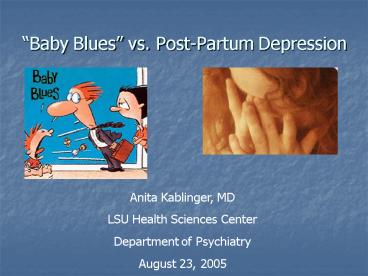Baby Blues vs. PostPartum Depression PowerPoint PPT Presentation
1 / 17
Title: Baby Blues vs. PostPartum Depression
1
Baby Blues vs. Post-Partum Depression
Anita Kablinger, MD LSU Health Sciences
Center Department of Psychiatry August 23, 2005
2
Baby Blues vs. Post-Partum DepressionOnset
3
Baby Blues vs. Post-Partum DepressionPrevalence
4
Postpartum Depression
- Highest vulnerability is in first 3 months after
delivery - Three types of postpartum disturbances
- Postpartum blues (baby blues)
- Postpartum depression
- Postpartum psychosis
- Postpartum depression should be distinguished
from postpartum adjustment
5
Post Partum Psychosis
- Rare occurs in 0.1-0.2 of births
- Usually occurs 3-6 weeks after delivery
- Higher risk associated with bipolar disorder and
schizoaffective disorder patients - Postpartum Psychosis, untreated, can lead to
- Child Abuse
- Suicide
- Infanticide
6
Post-Partum PsychosisSymptoms
- Delusions
- Hallucinations
- Sleep disturbances
- Obsessive thoughts about the baby
- Rapid mood swings (which mimic bipolar disorder)
- Extreme anxiety, agitation
- Suicidal and homicidal thoughts
7
Post-Partum DepressionEmotional Symptoms
- Increased Crying
- Irritability
- Hopelessness
- Loneliness
- Sadness
- Uncontrollable mood swings
- Feeling overwhelmed
- Guilt
- Fear of hurting self or baby
8
Post-Partum DepressionBehavioral Symptoms
- Lack of, or too much, interest in the baby
- Poor self-care
- Loss of interest in otherwise normally
stimulating activities - Social withdrawal and isolation
- Poor concentration, confusion
9
Post-Partum DepressionPhysical Symptoms
- Exhaustion, fatigue
- Sluggishness
- Sleeping problems (not related to screaming baby)
- Appetite changes
- Headaches
- Chest pain
- Heart Palpitations
- Hyperventilation
10
Post-Partum DepressionRisk Factors
- Self or family history of mental illness or
substance abuse - Marital or financial stresses
- Birth complications
- Lack of self-confidence as a parent
11
Post-Partum DepressionRisk Factors
- Problems with babys health
- Major life changes around time of delivery
- Lack of support or help with baby
- The mother being of young age
- Severe premenstrual syndrome
12
Post-Partum DepressionCauses
- Exact cause not known. Levels of estrogen,
progesterone, cortisol, and thyroid hormones drop
sharply after birth. - The brunt of the research has been in testing
hormonal connections
13
Post-Partum DepressionDiagnosis
- The Edinburgh Postnatal Depression Scale (EPDS)
is a 10-item self-rated questionnaire used
extensively for detection of postpartum
depression. A score of 12 or more on EPDS or an
affirmative answer on question 10 (presence of
suicidal thoughts) requires more thorough
evaluation.
14
Post-Partum DepressionDiagnosis
- Important to rule out medical causes of
depression, such as anemia or thyroid dysfunction - Check medical history
- Perform physical examination/lab tests
15
Post-Partum DepressionTreatment
- Treatments can include
- Counseling/psychotherapy
- Medication
- Support groups
- Self-help
- For mild to moderate symptoms, focus less on
pharmacological treatment and more on counseling
and group therapy. - All antidepressants pass through breast milk.
16
Post-Partum DepressionTreatment
- Medications
- First-line choices are SSRIs such as fluoxetine
(Prozac) 10-60 mg/d, sertraline (Zoloft) 50-200
mg/d, paroxetine (Paxil) 20-60 mg/d, citalopram
(Celexa) 20-60 mg/d, or escitalopram (Lexapro)
10-20 mg/d - SNRIs such as venlafaxine (Effexor) 75-300 mg/d
or duloxetine (Cymbalta) 40-60 mg/d, are also
highly effective for depression and anxiety. - ECT is effective for those with severe
depression/psychosis
17
Post-Partum DepressionTreatment
- In addition to counseling or talk-therapy
(individual or group therapy), other steps can be
taken by the mother to fight the depressive
symptoms - Exercise
- Eat healthy
- Use an outlet, such as a diary, a family member,
or a friend. - Try not to isolate ones self
- Promote sleep
- Take breaks, and make time to do the things you
enjoy

